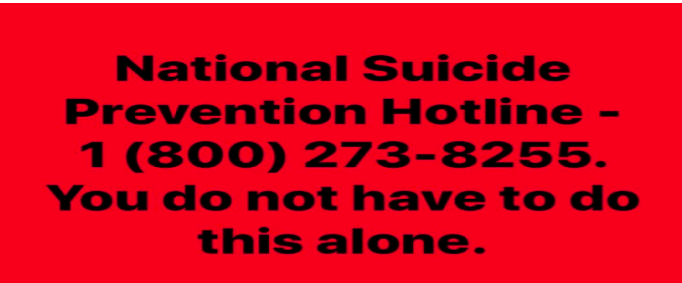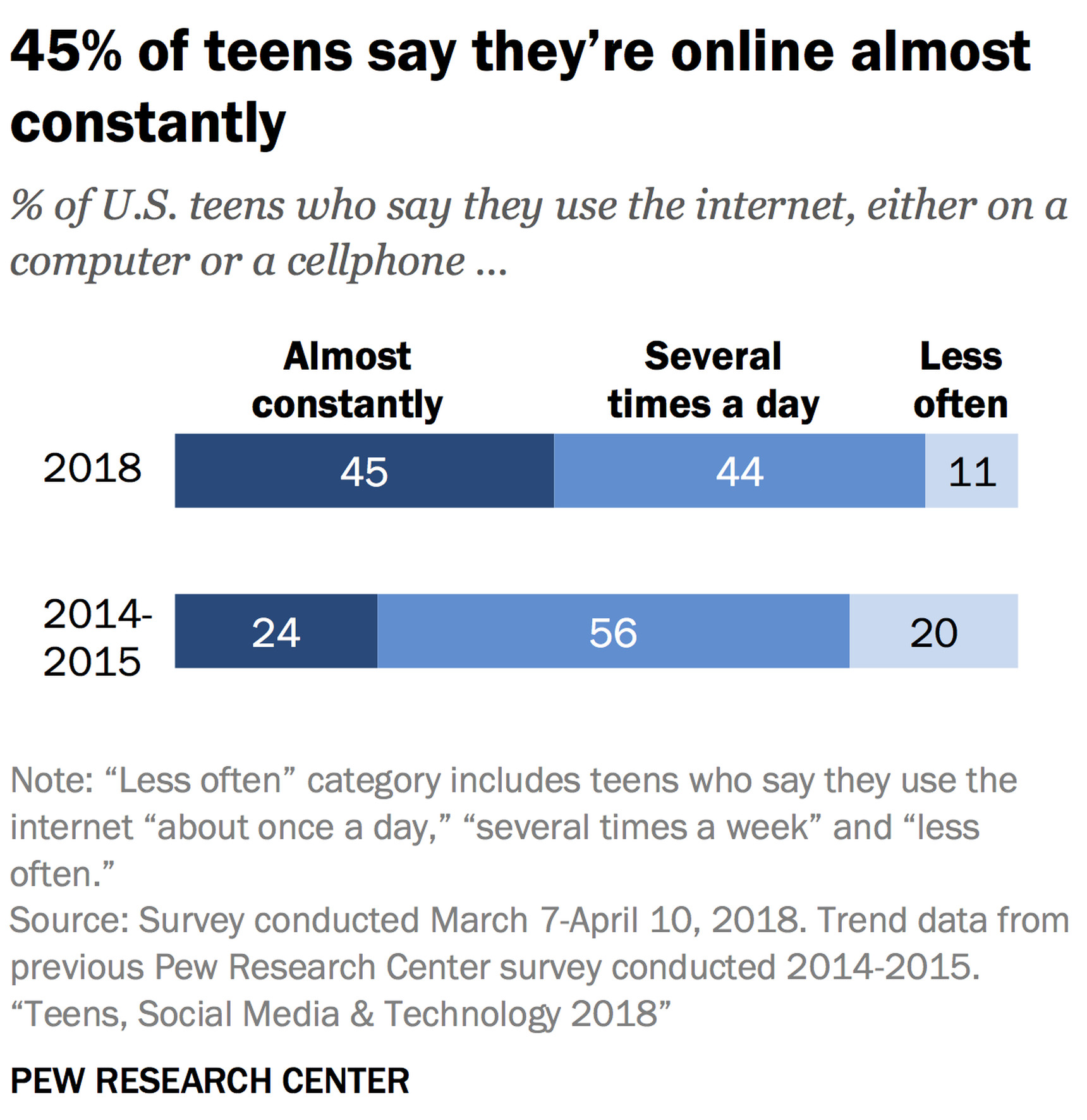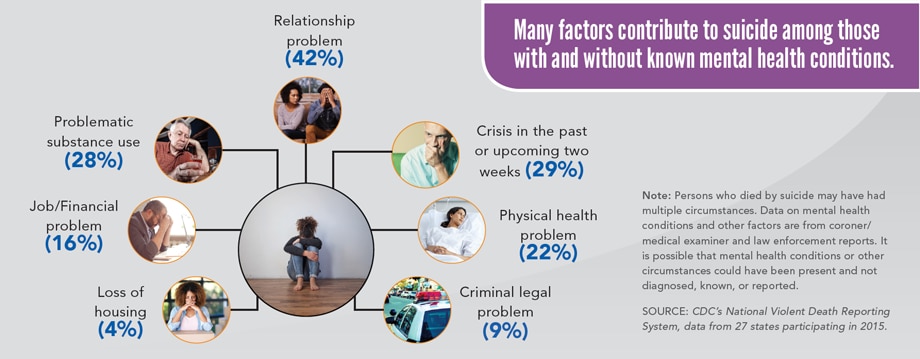
By Bob Shanahan
I really hope this article doesn’t depress you as it did me while I was researching it. But this is an important subject that must be discussed and properly dissected.
Here’s a shocking and telling statistic on the direction of American society today: suicide rates have risen sharply in every U.S. state (except Nevada, which was already alarmingly high) from 1999 to 2016, according to the Centers for Disease Control and Prevention. Suicide rates are up more than 30 percent in half of the states over the last couple decades. There were 45,000 suicides in 2016, up from 44,193 in 2015. Suicides on average across the nation have increased by 25%.
Depression, isolation, opioids, technology, and substance abuse are to blame. But more important than the causes is the fact that we need to learn to talk about this, open up with how we’re feeling to those closest to us, and learn how to handle life on life’s terms instead of ending it all. Taking one’s own life is tragic yet cowardly and the dramatic spike should be of utmost concern to every American.
In addition to these stunning statistics, the very recent deaths of public figures Anthony Bourdain and Kate Spade put suicide back in the spotlight. This is a disturbing trend that has to be dealt with so we can stop people from taking their own life. But how is one to know someone is in trouble of harming themselves or ending their life when they exhibit no mental health issues of any kind and don’t want to talk about it at all?
The most tragic facet of this suicide epidemic is the fact that the CDC found that about half of those who commit suicide suffer from mental health issues like depression, while 55% of contained no mental health disorder of any kind. Other factors contributing to the spike in suicides over the years were: relationship stress, financial troubles, and substance abuse. And the trend is seen across all Americans of all races and incomes, but the biggest takeaway from the numbers is that white men are killing themselves at alarming rates: white males accounted for 7 of 10 suicides in 2016.
“From 1999 to 2015, suicide rates increased among both sexes, all racial/ethnic groups, and all urbanization levels,” wrote the CDC researchers in its report. Furthermore, suicide is now the 10th leading cause of death in America and for every successful suicide, there another 25 unsuccessful attempts.
It cuts across age, ethnicity, gender, and is occuring everywhere in the U.S. States with the highest percentage increases were: North Dakota, Vermont, New Hampshire, Utah, and Kansas, each recording a 45% or more increase in suicides over the last 30 years.
Firearms were used in about half of all suicides.
Here are more stats on the Americans who have committed suicide in recent years:
- 42% had relationship issues
- 29% had some kind of crisis
- 28% had substance abuse issues
- 22% had physical health issues
- 16% had job or financial problems
- 9% had criminal or legal problems

Image from Statista
The underlying conundrum is, according to medical professionals, finding adequate and proper mental health treatment. Even for those who are adequately insured and can afford mental health treatment, it is exceedingly difficult to cater the right treatment for each individual.
What I have not mentioned yet is the social media age we live in today. Americans are increasingly connecting with people online and failing to make connections with people in everyday life. When we are supposed to be more connected than ever, a great feeling of loneliness arises from an overwhelming sense of isolation stemming from failing to experience real interactions with people in-the-flesh. Technology is keeping us apart from other human beings who all deep down desire real and authentic human connection, no matter how introverted or shy you are.
But we are all glued to our smartphones and living in an increasingly electronic world, failing to really live and be present in the world we are inhabiting.
According to a recent survey by Pew Research, 45% of American teens say they are online “almost constantly,” about double what it was just 3 years ago.
The smartphone generations (Millennials and Gen Z) have become a swaths of lonely humans addicted to their gadgets. An astonishing 95% of American teens have access to a smartphone, according to the same Pew survey. Smartphone technology is insidiously designed to be more addictive and trigger our brains to crave that ding we hear when we get a new text or Facebook like or retweet.
The media continues to report about digital addiction, but they continue to fail to address the effect that cell phone and WiFi radiation exposure has on the brain, as B.N. Frank points out in a recent post on Activist Post. Research has shown that being exposed to a cell phone and WiFi radiation disrupts the blood-brain barrier which can cause it to leak.
Frank continues, writing that there has been “no ‘safe’ level of cell phone or WiFi radiation” that has “been scientifically determined for children or pregnant women.” But WiFi and smartphones and tablets keep becoming a larger part of our society and everyday life and are even being introduced in schools replacing physical textbooks. While technology continues to be pushed in the classroom, tech inventors have been limiting their own children’s use of it and sending them to private “low tech” schools. In addition, your tax dollars are being spent to make public schools “high tech.”

Image from Pew Research Center
This is no conspiracy theory. This is not a scare tactic. This is reality. Backed up by scientific research. And it’s eroding our society and degrading our culture in a multitude of ways, leading to the continued rise of suicides across the country.
One least point on cell phone and wireless technology is worth mentioning. In 2011, cell phone and wireless WiFi radiation were classified as a Group 2B Possible Carcinogen by the World Health Organization.
There is something very wrong with our culture today. On average, there are 123 suicides that occur everyday in the U.S.
Please… If you or someone you know needs help, call the National Suicide Prevention Lifeline at 1-800-273-TALK.
Americans are today suffering from unprecedented levels of emotional despair. Johann Hari, an unparalleled voice on the subject of addiction and mental health, notes that the epidemic of depression in the Western World is not always caused by our brains, it is mostly caused by key problems in the way we live our lives. We exist in a disconnected state from our families, friends, and communities, while clinging to a superficial connection of interactions online and on social media.
As materialistic Americans, we always think some kind of change in our lives or some kind of financial improvement will make us feel more fulfilled and less depressed. If only we get that big raise or that promotion or buy that new house or finally have children, then we will really be happy. But almost always, we won’t. Our culture prioritizes escalating financial and personal achievements while neglecting our inner most desires for connection, community, contentment, and happiness. We need to embrace therapy when we feel we are without hope. We need to make meaningful connections with people in real life and build a support group of family, friends, and colleagues to create a lasting peace through authentic interaction with other people.
“Changing our culture is critical,” Kirsten Powers writes in USA Today. “Being honest with others about our own personal struggles and dark nights of the soul is the first step. People on the edge need to hear stories that assure them there is a way through the all-consuming pain to a meaningful life.” If we get to that point of talking about our personal issues openly and honestly then we can perhaps make a real dent in reducing the amount of depression and eventually suicides ravaging our great nation.
“The gray drizzle of horror induced by depression takes on the quality of physical pain.”
William Styron, born on this day in 1925, on what depression is really like: t.co/ARwRDiQxdg
— Maria Popova (@brainpicker) June 12, 2018
It all comes down to that unyielding sense of isolation that is affecting millions of Americans.
Adam Taggart wrote a great piece in PeakProsperity, titled, “Feeling Isolated?” last week delving into how lonely and isolated we are in America today.
The number one most commonly-reported complaint Taggart and his colleagues hear is that they feel alone and isolated. This is because as humans, we are biologically wired for social connection and meaningful interaction. Up until quite recently, humans lived in small tribal groups of 60 people or less where unity and cohesiveness were required for the tribe to survive. Each member of the group had an important role to play in maintaining the survival of the group, facing adversity and conflict together and living meaningful lives with a people they maintained intimate bonds with.
In a podcast with author Sebastian Junger, who wrote the great book, Tribe: On Homecoming and Belonging, which I’ve read and would recommend to you all, Junger discusses how modern life is so far removed from the lives our ancestors evolved from. We are quite disconnected from each other and the sense of community is gone as we are glued to our smartphones and obsessing over our number of friends and likes on social media.
One disturbing point Junger makes in Tribe is about veterans struggling to find meaning in their everyday lives back in the U.S. after returning from war. A telling reality of how messed up our society and culture have become today is the fact that most veterans would prefer life in a conflict zone, facing bullets and the constant threat of death or attack, than live in the isolated states of America. Veterans are committing suicide at the rate of over 20 deaths a day. A sobering statistic that is brought on by the spike in opioid drug overdoses, which are occuring at twice the rate of the civilian population. Veterans have essentially lost their tribe and their closeness that comes with being part of a group and serving a real purpose in life.

Image from the CDC
But veterans are far from the only ones feeling this sense of alienation. In today’s digital/social media world, our interaction with others is increasingly virtual. “In the sprawl of suburbia, we live in densely-packed cul-de-sacs yet hardly know our next-door neighbors’ names,” Taggart writes. “The fast-growing wealth gap is forcing the 99% to work harder just to make ends meet, leaving little time left in the week for socializing or family interaction.” Therefore, the U.S. is experiencing an undeniable epidemic of loneliness and depression.
A study released by Cigna in May revealed how Generation Z is the worst off, undoubtedly dubbed the loneliest generation. Americans experiencing loneliness has reached “epidemic levels,” according to Cigna’s U.S. Loneliness Index, which surveyed over 200,000 U.S. adults. The index almost exactly mirrors the 45% of American teens who say they are online constantly as 46% of those surveyed say they always feel alone and 47% feel left out. Younger generations feel far lonelier than older ones as more than half of Gen Zers identified with 10 of the 11 feelings associated with loneliness.
But adults are suffering too. According to former Surgeon General Vivek Murthy, at least 40% of all American adults report feeling lonely, with loneliness rates doubling since the 1980s during the most technologically connected society to date. Furthermore, the number of people who report having a close confidante in their lives has been declining over the past few decades while the average number of square feet of our homes has been skyrocketing (new homes are 1,000 square feet larger than they were in 1973).
The social media bubble is real and is upending our culture of connection and human interaction. A recent study by Harvard Business Review confirmed that the more we use Facebook, the worse our physical health, mental health and life satisfaction. Most telling is the fact that former Facebook executives have gone public with their fears that it’s “ripping apart society” by “exploiting a vulnerability in human psychology” as we put our best lives out there for the world to see while masking the real issues we have going on and making others feel that their lives are inadequate or missing something.
It is imperative to not feel shame or guilt for feeling lonely or isolated. Reaching out and asking for help is essential to getting your life back on a path toward lasting happiness. We need to recognize loneliness for what it is, a human condition and one that can be done away with if the proper actions are taken. We need to fight past our isolating tendencies and engage more directly with others in everyday life.
As I’ve stated, human beings crave connection, whether you believe that or not. But these connections must be of high quality, not quantity. You don’t have to be a social butterfly to feel the full benefits of authentic social connection. You only need a few meaningful relationships at a minimum. But they have to be in-the-flesh face-to-face interactions. Facebook messaging or replying via Twitter comments do not count.
Here are several sources PeakProsperity references that offer guidance for creating a community and building relationships:
- 75 Actions That Build Community
- Peak Prosperity’s Community Building Wiki page
- Success Factors for Developing a Sense of Community
- Chapters 10 & 11, “Emotional & Social Capital,” from Prosper!: How to Plan for the Future & Create a World Worth Inheriting
If you’re struggling, don’t be ashamed to ask for help. If you are depressed, anxious or lonely, talk about it. Reach out. If you need a professional therapist, go find one and get help. Suicide is never the answer. There is a way to improve your life and get you out of the social media bubble of isolation. Look for people in real life and form meaningful bonds and connections with others in your community. You are not alone. You can live a happy and fulfilling life if you take the right steps toward improving your current situation, no matter how dire.
Follow me @BobShanahanMan
Bob is a freelance journalist and researcher. He remains forever skeptical of the mainstream media narrative and dedicated to uncovering the truth. Bob writes about politics (in DC and CA), economics, cultural trends, public policy, media, history, real estate, Trump Derangement Syndrome, and geopolitics. Bob grew up in Northern California, went to college in Southern California, and lived 4+ years in Seattle. He now lives in sunny Sacramento. His writing also appears in Citizen Truth and has been posted on ZeroHedge.